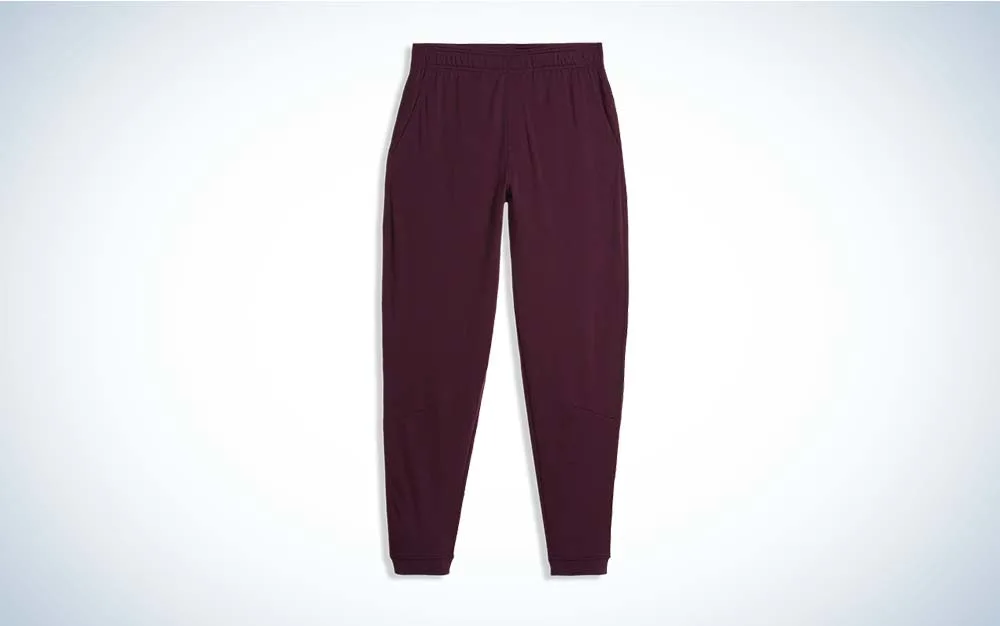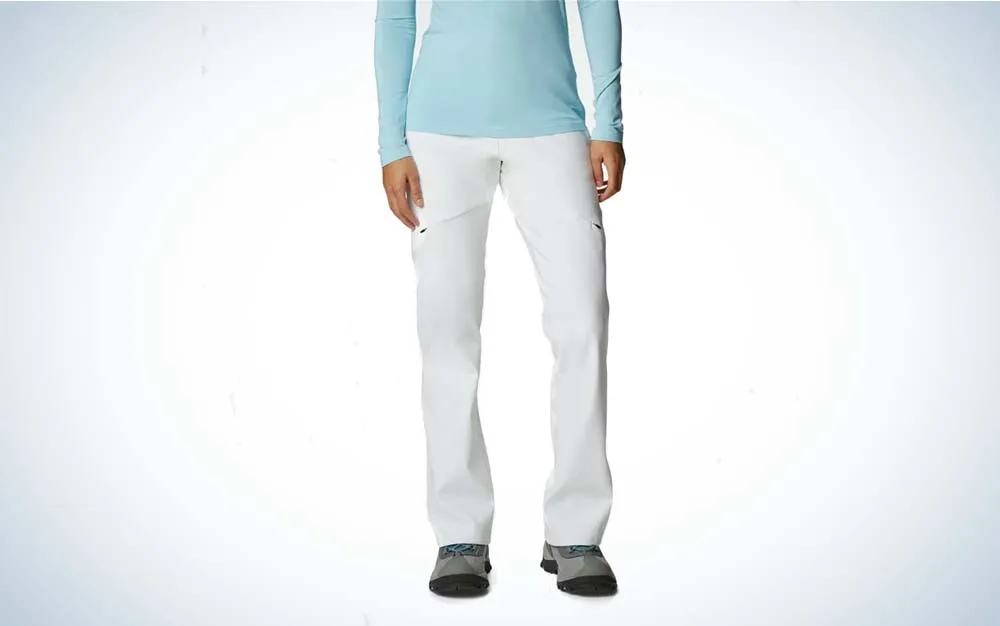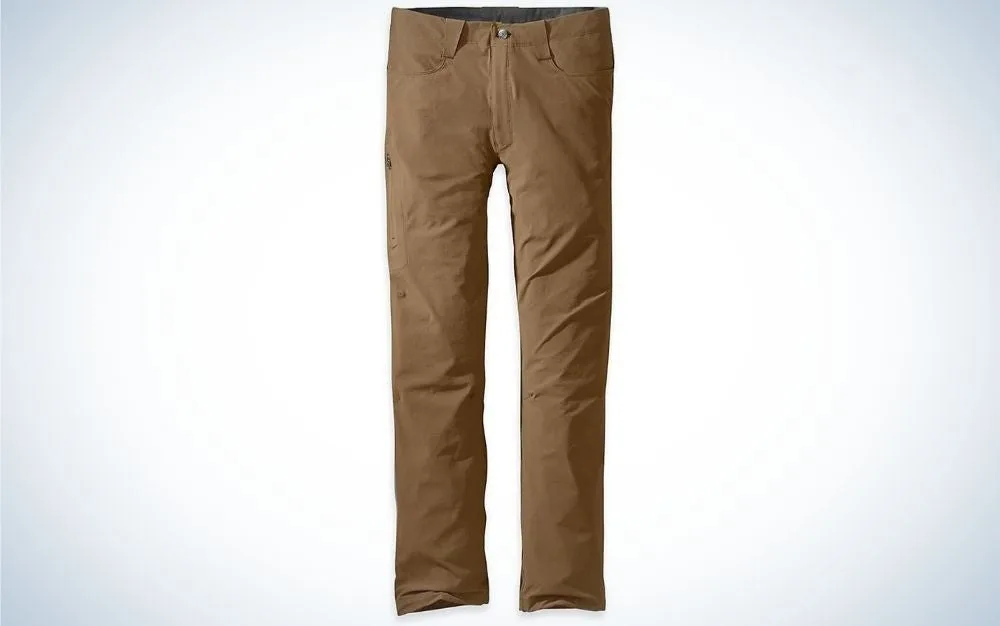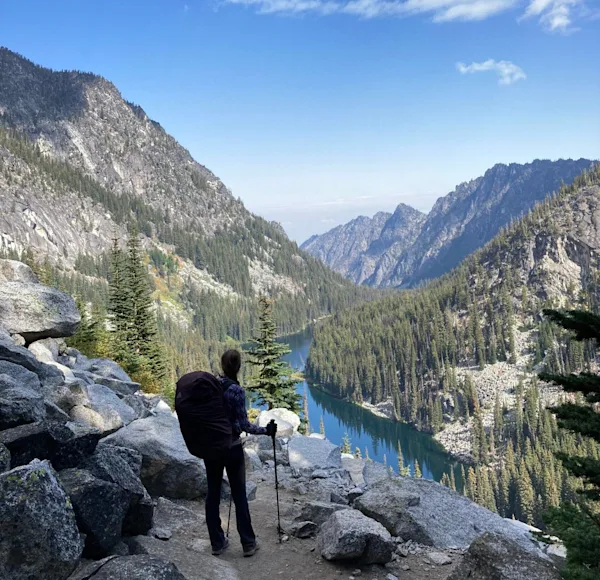_We may earn revenue from the products available on this page and participate in affiliate programs. Learn more ›
_
Best Overall

Prana Stretch Zion
Best Wool

Ibex Nomad Joggers
Most Versatile

Arc’teryx Gamma Pants
You need hiking pants that not only have the flexibility to step over logs and scramble over rocks, but also provide the level of protection necessary for the climate, terrain, and ecosystem.
While you could throw on your jeans for a weekend out, having the best hiking pants can enhance your outdoor experience. Because if you’re dressed properly, you’ll enjoy your time outdoors more. And rugged pants designed with trail use in mind will last you for years to come.
We’ve not only collected our top picks for the best hiking pants, but we’ve put together the information you need to make an educated purchase decision.
Best Overall: Prana Stretch Zion
Best Wool: Ibex Nomad Jogger
Most Versatile: Arc’teryx Gamma Pants
Best for Winter: Columbia Passo Alto II Heat Pant
Best for Men: Outdoor Research Ferrosi Pants
Best for Women: Mountain Hardwear Dynama Ankle Pants
How We Made Our Picks
Hiking pants are among the most important part of your setup in the backcountry. After all, if you aren’t comfortable, protected, and able to move freely, it is hard to enjoy your hike.
The best hiking pants on our list were picked using a variety of criteria, including:
Functionality: What features do they have to make them optimal for hiking? Does the style fit my needs? Are the additional features optimizing performance? Are the pockets in a location that makes them easy to access? Are the materials used functional for the environments I’m hiking? What type of protection do they provide?
Mobility: Is the material restrictive to my movement, or will it stretch? Are the waist and seams in good locations for a wide range of movement?
Durability: What type of fabric is used? Is it ripstop? Are there reinforced seams? Does it have a double weave of any material? Are there weak spots in high-use areas? Does the company have a warranty or repair policy?
Versatility: Can I use these pants during multiple seasons? Does the style allow for pant conversion of any kind? Are they stylish to wear outside of hiking?
Other helpful considerations were if any recycled materials were used, general sustainable practices by the company, and a deep dive into verified customer reviews to get a full picture of use.
The Best Hiking Pants: Reviews and Recommendations
Best Overall: Prana Stretch Zion
Best Overall

Key Features
Weight: 13.6-14.2 oz
Materials: 97% nylon, 3% spandex
Water Resistance: DWR finish
Why It Made the Cut
Prana Stretch Zion pants were chosen as the best overall hiking pants because of their durability, versatility, and general comfort while in motion.
Pros
Features: built-in-belt and good pockets
Durable: primarily nylon material
Flexibility: great for hiking and climbing
Cons
Breathability: DWR treatment keeps it water-resistant but not as breathable
As you may have gathered from the name, the Prana Stretch Zion
pants are incredibly stretchy. The stretch built into the pants makes them highly versatile, and gives you more freedom of movement when hiking. These pants are designed with a semi-slim cut meant to move with you, making them perfect for things like rock scrambling, high stepping, and other high-mobility movements.
, and this does impact the breathability to an extent. The materials are relatively lightweight, so these pants can still comfortably be worn in warmer months. There is an additional roll-up feature for further venting.
The fabric of the pant itself is still thick enough to be mighty durable. Walking through brush or using these for rock climbing would be a perfect fit, and your pants will stand up to these types of field tests. Overall, they are extremely durable and versatile, and what they lack in breathability, they make up for in performance.
**Best Wool: Ibex Nomad Joggers
**
Best Wool

Key Features
Weight: N/A
Materials: 95% Merino Wool, 5% Elastane
Water Resistance: none
Why It Made the Cut
The Ibex Nomad Joggers bring the traditional jogger comfort and style to the trail.
Pros
Warm and comfortable
A great midlayer option
More functional than cotton joggers
Moisture wicking merino wool
Cons
Warmer than you’d think while hiking
Not as durable as expected
You can easily wear the Ibex Nomad Joggers, lounging around home, running errands, or hiking in the woods. They are exceedingly comfortable, and since they are not made of cotton, they’re lighter weight, better at thermoregulating, and safer to wear in cold, wet climates.
As far as wool goes, Merino wool is relatively easy to take care of
, but it isn’t the most durable material. It is worth noting that these pants may be more prone to ripping or snagging than synthetic fabrics because of the material type. The good news is that these pants make up for that aspect in functionality elsewhere. If you wear these pants backpacking, they do not hold onto smell as synthetics would, and when paired with the right baselayer, they make for an excellent colder-weather backpacking option.
While wool pants may not be the first consideration for hiking, if you enjoy going outside year-round, these are a great choice. What I liked about them most was their versatility. They are so cozy and comfortable that they also become a go-to lounge pant choice. Whether you use them for casual wear, travel, or the trail, you will not be disappointed.
Most Versatile: Arc’teryx Gamma
Most Versatile

Key Features
Weight: 11.6 oz
Materials: 88% Nylon 12% Elastane
Water Resistance: DWR
Why It Made the Cut
The Arc’teryx Gamma pants are comfortable next to your skin and highly durable when hiking, climbing, backpacking, and beyond.
Pros
Style: relaxed, minimal, long pant design
Comfort: loose-fitting with freedom of movement
Durable: quality materials
Cons
Looser fit than the previous Gamma LT design (pro for some users)
The Arc’teryx Gamma pants are a top pick for the best hot weather hiking pants. They have a low profile, making them versatile for wearing around town and on the trail. The lightweight materials allow for a higher level of breathability, but the quality of the fabric keeps them durable for years of use.
They are relatively loose-fitting pants, but they are not so baggy to be uncomfortable or snag while hiking. Their cut provides an excellent range of motion for most outdoor activities, and the material blend is comfortable against your skin even in temperatures over 90 degrees Fahrenheit.
With their high level of breathability and intentional design for warm weather, they have a DWR treatment but are still relatively breathable. The materials are quick-drying and moisture channeling, though, so if they do get wet, they won’t stay that way for long. These are a versatile and stylish pair of hiking pants that you can use while climbing, backpacking, or around town.
Best for Winter: Columbia Passo Alto II Heat Pant
Best for Winter

Key Features
Weight: 10.7 oz
Materials: 93% Polyester, 7% Elastane
Water Resistance: N/A
Why It Made The Cut
The Columbia Passo Alto II Heat Pants are a winter hiker’s best friend with an Omni-heat thermal reflective lining and water resistance.
Pros
Lightweight but warm pants
Excellent water resistance for snow
Stretch materials for mobility while hiking
Wide leg to accommodate boots
Cons
The sizing is inconsistent. We recommend trying pants on in person.
If standard hiking pants are not cutting it during cold weather hikes, then consider the Columbia Passo Alto II Heat Pants. While they look and feel like traditional hiking pants, what sets these apart is the unique Omni-heat lining. Unlike insulated or fleece-lined pants, Omni-heat reflects your body heat back to you. So, as you hike, your body stays warm. When you’re not in motion, these pants won’t be quite as warm. They are designed to be worn while moving, which is when they perform best.
Although I did not have an issue with sizing, many verified customer reviews complained of sizing issues. The best way to avoid this issue is to purchase the pants in-store so you can try them on first. If you do buy them online, evaluate the Columbia sizing chart
.
Once you find the right size, these pants are ideal for cold-weather hikes, snowshoeing, working outside during winter, or daily dog walks. Since they’re designed to be worn during winter, the leg opening is slightly flared to accommodate comfortably wearing boots. They are made from durable materials, have adequate pockets (even on the women’s design), and help you stay warm as you hike.
Best for Men: Outdoor Research Ferrosi Pants
Best for Men

Key Features
Weight: 12.2 oz
Materials: 86% nylon, 14% spandex
Water Resistance: DWR finish
Why It Made the Cut
The OR Ferrosi Pants are an affordable option for hikers in search of versatile and durable pants that will keep them comfortable during several hiking seasons.
Pros
Mobility: great stretch
Comfort: all-day wear
Durable: ripstop fabric
Cons
Three-Season: not suitable for cold weather
This style of Outdoor Research pants contains a higher level of spandex to help increase their mobility and stretch for even the highest steps while you hike. They are made with ripstop fabric to increase durability and prevent any rips on the trail. Making these pants the best hiking pants for men.
The material is very light and relatively thin, making them great for warm weather and shoulder seasons if you have extra layers. They are not the best hiking pant for cold weather and may even be chilly if the wind picks up, and temperatures drop.
To make them even better performers in warm weather, there is a built-in drawcord cuff to allow you to roll them up and sinch them down on your calf. Some wearers experience the waist loosening after several wears, and a belt may be necessary for extended days wearing the same pair of pants in the backcountry.
Best for Women: Mountain Hardwear Dynama Ankle Pants
Best for Women

Key Features
Weight: 8.46 oz
Materials: 94% nylon, 6% elastane
Water Resistance: DWR finish
Why It Made the Cut
The Dynama Ankle pant made by Mountain Hardwear is an excellent women’s outdoor pant with plenty of stretch and mobility without the unnecessary tightness of leggings.
Pros
Fit: loose but feminine fit
Function: stretch and storage
Material: breathable and odor-resistant
Cons
Length: ankle pant (pro to some)
Women’s hiking pants can be hit or miss because of body size and functionality. As our pick for best hiking pants for women the Mountain Hardwear Dynama Ankle Pants took these factors into account when designing these pants. The design of the pants is flattering on most body types and the length makes them usable for both petite and long-legged ladies.
These are pants you can wear for days on the trail and then out on the town as you return to civilization. The style of the pant is just one part of this design though. They are extremely functional and allow for an ideal range of motion when hiking, climbing, and more.
Although they do not cover your ankle, they do provide quality UPF protection and water resistance without compromising breathability. Due to the fabric weight and pant length, these pants are only suitable for mild weather but can easily be used during three seasons. What’s more is that they have deep, usable pockets (a rarity in female clothing).
Things to Consider Before Buying Hiking Pants
Like any part of your outdoor gear, your hiking clothing should check several boxes before you choose to buy them and then wear them on the trail.
The best hiking pants are the ones you feel comfortable and confident wearing for the conditions you are hiking in. The following are the top considerations that can help you choose the best hiking pants for your needs.
Style
When looking for the best hiking pants, the style of the pant will be an essential factor. Hiking pants will often fall into three categories:
Convertible pants (zip off to go from pant to shorts)
Roll-up pants
Long or minimal design pants
The style of pants you choose will likely be a personal preference based on your intended use and how they make you feel while you wear them. For instance, I don’t like the feel of most convertible pants. I often opt for roll-up pants with similar versatility but a higher level of personal comfort.
The style of the pant will also impact its versatility. Say you’re looking for pants you can wear in hot and cold weather. Some hikers prefer the convertible pants. But if the standard minimal, long pants are lightweight enough, they can still work for several seasons.
Durability
The material the pants are made from will impact their durability dramatically. At the moment, synthetic materials like nylon and polyester blends seem to be the best performing in the hiking pant realm. This is primarily because of their high melting point and lack of ability to break down in natural conditions.
Other than the material itself, looking at the seams and reinforced areas is helpful. Pants meant for outdoor use tend to be more durable when they have reinforced seams, knee areas, and rear panels. These high-use spots are the easiest to rip when in use, so additional support helps them last longer.
Keep in mind that when a fabric has a tighter weave and has reinforced panels, it may not be as breathable or comfortable to wear when hiking in hot weather.
You can get a good idea of a pants durability by looking at verified customer reviews. Read through these to see if there are complaints regarding the durability or comments on how durable they are.
Lastly, look at the companies repair policy. Most consumer-focused companies will have a repair policy in place for clothing to prolong the use of their product.
Breathability
The breathability of the pant is going to be especially important if you hike in warm weather conditions or a humid climate. However, a pant built specifically for hot weather hiking will not be optimal for cold or wet weather due to its breathability.
So, if you’re looking for all-season pants, then you may have to sacrifice some breathability to allow for layering and cold/wet weather protection.
Three-season and warm weather pants will feature things to help increase airflow, like mesh panels or mesh pockets. Another reason so many brands opt to make pants from synthetic materials is their ability to dry quickly while you sweat.
The weight of the pant will tell you a lot about breathability. A lighter-weight pant tends to be more breathable. So, if you want summer hiking pants, look for a lightweight fabric with mesh vents.
Protection
The three main areas to look for protection in hiking pants include water, insect, and sun. All three of these things are essential, especially for pants you use for multiple seasons.
Water protection: Not all hiking pants are completely waterproof, and that’s not a bad thing. Looking for water-repellent pants can be tricky because it does impact breathability. If you want more water protection, look for DWR (durable water repellent) coatings. Pants with DWR coating will do a better job shedding water but will not prevent soaking. These coatings wear off with use and washing, so you’ll need to re-apply over time. If you don’t want to compromise breathability, you can also opt to carry rain pants to put on over your pants if needed.
Insect protection: Wearing long pants will already have better protection from insects, but additional treatments like permethrin can help keep those bugs away even more effectively. Certain ecosystems, like ones with ticks, will make having treated pants more relevant. You can also treat clothing on your own, but understand the risks of these types of chemicals and treat pants away from children and pets.
Sun protection: Pants will always give you more protection from the sun, but one way to know how much is to look at the UPF (ultraviolet protection factor) rating on the clothing. UPF ratings tell you how many ultraviolet rays can get through the material. Much like sunscreen, a higher UPF rating means better protection. Things that influence the UPF ratings include the type of fabric, how tight the weave is, and any chemical treatments or dyes.
Read Next: Best Hiking Shirts
FAQs
Q: Can I wear jeans hiking?
Yes, you can wear anything hiking, but jeans won’t be very comfortable or safe to hike in pending the climate and weather forecast. Jeans are made from cotton, meaning they are heavy, not as breathable, and they hold onto moisture.
Q: Is it bad to wear shorts while hiking?
No, you can wear shorts while hiking. The time of year, weather conditions, and location you are hiking can make it bad to wear shorts. For instance, if you are hiking in the summer but you will be going through an area that has a lot of ticks or shrubs you have to walk through, shorts are not the most sensible option.
Q: What should you not wear while hiking?
You should not wear materials like cotton that are not moisture resistant, antimicrobial, and take a long time to dry. Look for clothing that is flexible, breathable, dries quickly, and is comfortable to wear during physical activity.
Final Thoughts on the Best Hiking Pants
Everyone will have a different top pick for their favorite hiking pants, and there are several deciding factors to help drive your decision. Our top picks for the best hiking pants for all seasons and body types take style, versatility, durability, and protection into account. With those factors driving your decision, it is easy to narrow down the best picks for your next adventure.
Why Trust Us
For more than 125 years, Field & Stream has been providing readers with honest and authentic coverage of outdoor gear. Our writers and editors eat, sleep, and breathe the outdoors, and that passion comes through in our product reviews. You can count on F&S to keep you up to date on the best new gear. And when we write about a product—whether it’s a bass lure or a backpack—we cover the good and the bad, so you know exactly what to expect before you decide to make a purchase.






